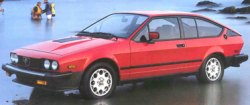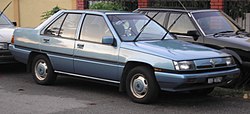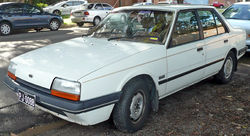TJ 5522 - BMW 525i A 1984 (E28)
 |
| 2+ yrs old Jimi in front of my 1984 BMW 525iA |
The BMW 525iA was my 5th car which I bought it from my friend in early 1987. It was a 1984 imported model with automatic transmission. That was the first car with auto-transmission I ever had.
 |
| this is a 23 yrs old picture of my 1984 BMW 525iA |
When I first drove the car, I felt really comfortable. It was far better than the Volvo 360 GLE that I've had earlier. At that time, BMW had just entered the heart of Malaysian behind Mercedes Benz and Volvo. BMW car was rarely on our road, especially in the east coast of peninsular.
 |
| Adik Na and Jimi posing at the rear side of my 1984 BMW 525iA...23 years ago |
BMW cars were considered as luxury cars, just like Mercedes, Volvo, Fiat and Alfa Romeo.
I have many personal memories with this car...the bitter, sour and sweet memoirs which I couldn't afford to forget them forever...The downward of my business and economy. The worst of it was, I have to sell the accident free car to avoid the same from being repossessed by the finance company. It appeared that I couldn't pay the monthly repayments/installments timely as per the terms of the hire-purchase agreement that I've entered into with the finance company. I've had tried to prolong the process until there was no subterfuge anymore. So...the complacent BMW has gone to the new lucky owner!
FACTS YOU MIGHT WANT TO KNOW ABOUT BMW 5 SERIES - E28
The
BMW E28 BMW 5-Series was made between 1981 and 1988. It replaced the
BMW E12 in 1981 and was replaced by the
BMW E34 in 1989.
E28 Production started in July 1981 and ended in December 1987. The E28 was still sold in North America as a 1988 Model Year car while Europe received the E34 towards the end of 1987.
BMW 5-Series (E28)
 |
| Manufacturer | BMW |
| Production | 1981–1988
722,328 built[1] |
| Predecessor | BMW E12 |
| Successor | BMW E34 |
| Class | Midsize (E) luxury |
| Engine | Petrol I4
1766 cc 90 hp (67 kW) - 105 hp (78 kW)
Petrol I6
1990 cc - 3453 cc
125 hp (93 kW) - 285 hp (213 kW)
Diesel I6
2443 cc 86 hp (64 kW) - 115 hp (86 kW) |
| Wheelbase | 2,628 mm (103.5 in) |
| Length | 4,620 mm (182 in) |
| Width | 1,700 mm (67 in) |
| Height | 1,415 mm (55.7 in) |
European model range
- 518 M10B18 carbureted engine, produced through 9/84
- 518i M10B18 fuel-injected engine, 1984 to 1987
- 520i M20B20 early, fuel-injected engine, 1981–1985
- 520i M20B20 late, fuel-injected engine, 1985–1987
- 524d M21D24 diesel 2.4 L engine, 1983–1988
- 524td M21D24 turbocharged diesel 2.4 L engine, 1983–1987
- 525i M30B25 fuel-injected (Motronic) 2.5 L engine, 1981–1987
- 525e M20B27 fuel-injected (Motronic) 2.7 L high efficiency engine, 1983–1988
- 528i M30B28 fuel-injected (LE-Jetronic) 2.8 L engine, 1981–1987
- 535i M30B34 fuel-injected (Motronic) 3.4 L engine.
- M535i M30B34 fuel-injected (Motronic) 3.4 L engine, with M-Technic aerodynamic kit, sport seats and unique 390 mm alloy wheels, 1985–1988
- M5 S38 fuel injected 3.5 L engine, 1985–1988
North American E28 range
All North American specification E28s (`82-`88) were comprehensively equipped. Power windows, central locking, air conditioning, power sunroof, cruise control, alloy wheels and fog lights were standard. In addition the 533i, 535i, 535is and M5 came standard with leather upholstery and on-board trip computer.
A 3-speed automatic was offered in the 528e in 1982-1983. It was also offered in the `83 533i. By 1984, the 4-speed version was introduced to both models. In 1986, the EH version was available in the 535i. It featured a 3-mode switch: E, S, 3-2-1.
Automatic transmission and limited-slip differential were optional on all models except the M5 and 524td. The 524td was only imported with an automatic transmission, and the M5 was only imported with a manual transmission.
Heated seats were optional in Canada and available in the USA only as an option on the M5. Consequently, few if any M5s were delivered without heated seats. Leather upholstery and an on-board trip computer were optional on the 528e and 524td.
From 1985 All E28s sold in North America had ABS Brakes as standard. Some `85 535i's were equipped with power seats.
From 1986 All E28s sold in North America had power-adjustable front seats as standard as well as an upgraded stereo.
- 524td: M21 2.4 L Straight-6 Turbodiesel engine, 114 hp (85 kW). Imported from 1985-1986.
- 528e: Sold from 1982-1988. Equipped with a 2.7L "High Efficiency" M20 6-Cylinder engine that produced 121 hp (90 kW) but 171 lb·ft (232 N·m) of torque. The engine uses the small port "200" casting cylinder head from the 2.0 L M20 with a special low duration cam to improve low rpm power and maximize efficiency. This engine is known as the "ETA" engine. For the 1988 model year, the engine was revised to produce 127 hp (95 kW), by using the cylinder head casting from the "i" motor installed on the "e" engine block with special pistons. The revised ETA engine is now known as the "super eta".
- 533i: A North American only model sold from 1983-1984 in limited quantities in response to customer complaints that the 528e had lower performance figures than the 1981 528i that it replaced. Equipped with a 181 hp (135 kW) 3.2 L M30 6-cylinder engine as fitted to the larger 633csi and 733i, it produced 195 lb·ft (264 N·m). torque. The compression ratio was 8.8:1. Top Speed was 134 mph (manual). The 533i was the fastest sedan sold in the USA in 1983.
- 535i: Replaced the 533i in 1985 and sold through 1988. The 535i featured a slightly larger 3.4L M30 6-Cylinder engine with 182 hp (136 kW) and greater torque. Compression was down to 8.0:1. Top speed also dropped to 131 mph (manual).
- 535is: Straight-6 with a sport suspension and interior and exterior modifications - 182 hp (135 kW). The 535is was available from 1987-1988. It incorporated M5 styling cues: front air-dam, rear spoiler, and sport seats.
- M5: A 1988 Model-Year only car equipped with a 24-Valve DOHC 256 hp (191 kW) 3.5L S38 engine. Limited in production the M5 was built from 11/86-11/87. The M5 was hand-assembled at BMW Motorsport in Garching, Germany. The M5 was available in America in Jet Black with Natur (Light Saddle) leather. A very small number of US spec M5s were built with black interiors. These are the most rare with a rumored 29 being built. The M5 also had leather door panels, lower dash and center console. Canadian-specification M5s were available with the option of a black leather interior. The M5 was equipped with its very own 7.5 x 16" BBS Wheels (not found on any other model)
Engines
The "baby six" engine found in the 520i, 525e and 528e models is known as the
M20, a 12 valve SOHC inline six cylinder design. It had seven main bearings and seven cam shaft bearings, a rocker arm type valvetrain driven by a composite rubber timing belt. US market M20s came with cast aluminum acoustically tuned, common plenum intake manifolds and a single throttle body. This engine was first available in the European market for model year 1976 in a 2.0 L carbureted version. It later grew to 2.3 L in the E21 323i, then 2.5 L in the E30 325i and also 2.7 L in the 325e and 528e models. It is also very similar to the later 24 valve engines as in the E36 and E46 3 series models, with the same basic block dimensions.
The big six engine found in the 528i, 533i and 535i/is models is known as the
M30. The M30 is also a 12 valve SOHC inline six cylinder design. It has seven main bearings, four camshaft bearings and a rocker arm type valvetrain. US M30's also came equipped with cast aluminum acoustically tuned common plenum intake manifolds and single throttle bodies. Unlike the M20 it has a chain-driven valvetrain. Its larger dimensions allow for a longer stroke and larger bore, which makes for almost 3.5 L displacement in later engines.
Both 533i and 535i M30 intake manifold from 1982-1988 had a "3.2/3.5" casting. During the new intake manifold's development a 3.2 L version existed in Europe and the US, and a 3.5 L in Europe. When the 3.4 L versions came out a year later in Europe, the casting was not changed. The 3.4 L was introduced to the US in 1985. 1988, was the last year this manifold casting was used in the E28 535i and 535is. A new style intake manifold was designed for the new 3.4 L. The casting read "3.5", but it was still 3.4 L (3430 cc). For the US, the 735i and the 635 csi were the first to receive the new M30 in 1988.
The M535i was introduced as a sporty version of the regular 535i, although the M535i does not feature any unique BMW Motorsport-designed drivetrain components it is, however, equipped with an M-Technic suspension, wheels and body panels not found on the standard 535i. Combined, these items distinguish the M535i from the regular 535i. The E28 M535i was introduced at the 1984 Paris Auto Salon. Unlike the hand-built E28 M5, the E28 M535i was assembled on the standard E28 assembly line in Dingolfing, outside of Munich.
An additional batch of cars was built at BMW's Rosslyn, South Africa factory using Complete Knock-Down kits supplied from Germany. BMW did not import the E28 M535i to North America for two reasons: 1) the M brand had not yet been established in North America at the time and thus held little equity with the consumer and 2) the cost of adapting the M-Technic body panels to fit the contours of the government-mandated bumpers was highly prohibitive. Instead, BMW of North America created the 535is, essentially a standard 535i equipped with front and rear spoilers, sport suspension and sport seats, which was sold exclusively in the U.S. and Canada. Total M535i production: 10335 cars.
The M5 came with a big six engine known as the
S38. This engine is similar to the M30, but has a 24 valve cylinder head, duplex timing chain, dual overhead cam layout and shim and bucket style valvetrain. In addition to the top end revisions, the S38 also had six individual throttle bodies and intake trumpets fed by a cast aluminum intake plenum. This engine was designed for high power and durability at very high engine speeds. In the E28 chassis it was one of the fastest sedans in the world for its time, and it remains legendary among enthusiasts today.
The E28 received the first BMW diesel engine ever, the
M21, in the 524td (85 KW; 115 HP). It was the fastest and most silent diesel car at the time. Later, a 524d version (63 KW; 85 HP), stripped of its turbo, was introduced.
 From 1974 to 1989, Alfa Romeo sold 135,000 copies of the Alfetta GT / GTV coupe. This car was derived from the Alfetta sedan. Both cars shared the same 1.6 / 1.8 / 2.0 twin-cam engines and a very unique drivetrain: a transaxle incorporating gearbox, clutch and differential mounted at the rear axle to give near perfect balance.
From 1974 to 1989, Alfa Romeo sold 135,000 copies of the Alfetta GT / GTV coupe. This car was derived from the Alfetta sedan. Both cars shared the same 1.6 / 1.8 / 2.0 twin-cam engines and a very unique drivetrain: a transaxle incorporating gearbox, clutch and differential mounted at the rear axle to give near perfect balance.  For many years, the V6 was regarded as the best V6 in mass production. Even after the GTV6 died in 1989, the V6 continued to evolve and powered many other Alfa cars, such as 75, 164, 155, GTV/Spider, 156, 166 and 147 GTA. During its 25 years life, it was enlarged to 3-litre and eventually 3.2-litre, with valve gears upgraded to quad-cam and 4 valves per cylinder.
For many years, the V6 was regarded as the best V6 in mass production. Even after the GTV6 died in 1989, the V6 continued to evolve and powered many other Alfa cars, such as 75, 164, 155, GTV/Spider, 156, 166 and 147 GTA. During its 25 years life, it was enlarged to 3-litre and eventually 3.2-litre, with valve gears upgraded to quad-cam and 4 valves per cylinder.






































